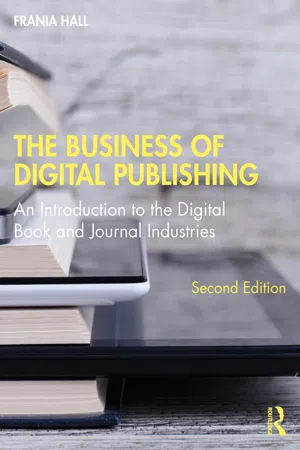
The Business of Digital Publishing
An Introduction to the Digital Book and Journal Industries
- 260 pages
- English
- ePUB (mobile friendly)
- Available on iOS & Android
The Business of Digital Publishing
An Introduction to the Digital Book and Journal Industries
About This Book
Thoroughly revised and updated throughout, the second edition of The Business of Digital Publishing provides an essential introduction to the development of digital products in the book and journal industries today.
Offering a fundamental overview of the main technological developments that have influenced the growth of digital publishing, the author introduces students to the key terms and concepts that make digital publishing possible. The four key publishing sectors (professional reference, academic, education and trade) are explored in detail, providing students with the technical literacy to understand digital developments and examine the growth of new business models. In this edition, sections have been updated to address the growth of audiobooks, reading apps, metadata, and open access, while original case studies address key issues such as digital-first publishing, EPUB, social media and crowdsourcing. Also covered are the key issues and debates that face the industry as a whole, such as pricing and copyright, and their impact on the industry is explored through relevant case studies. Taken together, the chapters examine the challenges of digital publishing and explore the opportunities it provides to develop new and diverse audiences.
The Business of Digital Publishing remains an invaluable resource for any publishing student looking for a starting point from which to explore the world of digital publishing.
Frequently asked questions
Information
Part ITechnology context for digital publishing
Introduction to Part I
- Developments in technology that led to digital production and new workflows
- Data structure that forms the basic building blocks of any digital product
- Web development and the implications for digital content
- Information architecture and content management for digital products
- The development and growth of e-readers and ebooks
1Developments towards digital production
Introduction
Developments towards digital publishing
- typesetting
- word processing
- desktop publishing (DTP)
- development of databases
Typesetting
Word processing
Desktop publishing systems
Database
Technological developments towards digital printing
- cost
- small print runs
- timing – just-in-time and print on demand
- lower stock holding
- lower shipping costs
- local printing options
Changing business models due to print on demand
Changing production processes and workflow


- the ability to adapt the output from just one input – so that from one ‘manuscript’ many formats can be produced
- the need to streamline effectively various parts of the process, which can lead to cost savings, where certain activities are less necessary, or time saving, where content can be managed quickly through the workflow with as little intervention as possible.
One input many outputs
- a print paperback (these can vary in size and binding)
- a print hardback (these too can be in different formats)
- ebook files of various sorts for different devices
- a PDF, which is often necessary for search inside mechanisms such as Amazon and Google
- ebook files that can then be manipulated further to form an enhanced ebook or app
- a file format that can be taken by aggregators to fit into their complex proprietary library databases
- formats designed to support different accessibility requirements such as documents sui...
Table of contents
- Cover
- Half-Title Page
- Title Page
- Copyright Page
- Dedication
- Table of Contents
- List of Illustrations
- Acknowledgements
- Introduction
- Part I Technology context for digital publishing
- Part II Publishing sectors
- Part III Digital publishing issues
- Final word
- Index